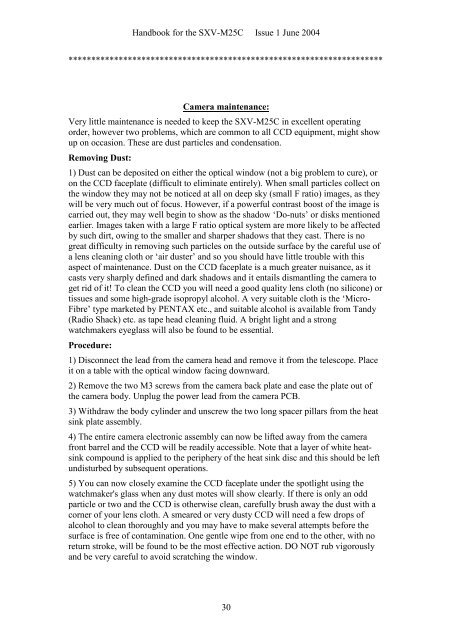SXVF-M25C handbook - Starlight Xpress
SXVF-M25C handbook - Starlight Xpress
SXVF-M25C handbook - Starlight Xpress
You also want an ePaper? Increase the reach of your titles
YUMPU automatically turns print PDFs into web optimized ePapers that Google loves.
Handbook for the SXV-<strong>M25C</strong> Issue 1 June 2004<br />
*********************************************************************<br />
Camera maintenance:<br />
Very little maintenance is needed to keep the SXV-<strong>M25C</strong> in excellent operating<br />
order, however two problems, which are common to all CCD equipment, might show<br />
up on occasion. These are dust particles and condensation.<br />
Removing Dust:<br />
1) Dust can be deposited on either the optical window (not a big problem to cure), or<br />
on the CCD faceplate (difficult to eliminate entirely). When small particles collect on<br />
the window they may not be noticed at all on deep sky (small F ratio) images, as they<br />
will be very much out of focus. However, if a powerful contrast boost of the image is<br />
carried out, they may well begin to show as the shadow ‘Do-nuts’ or disks mentioned<br />
earlier. Images taken with a large F ratio optical system are more likely to be affected<br />
by such dirt, owing to the smaller and sharper shadows that they cast. There is no<br />
great difficulty in removing such particles on the outside surface by the careful use of<br />
a lens cleaning cloth or ‘air duster’ and so you should have little trouble with this<br />
aspect of maintenance. Dust on the CCD faceplate is a much greater nuisance, as it<br />
casts very sharply defined and dark shadows and it entails dismantling the camera to<br />
get rid of it! To clean the CCD you will need a good quality lens cloth (no silicone) or<br />
tissues and some high-grade isopropyl alcohol. A very suitable cloth is the ‘Micro-<br />
Fibre’ type marketed by PENTAX etc., and suitable alcohol is available from Tandy<br />
(Radio Shack) etc. as tape head cleaning fluid. A bright light and a strong<br />
watchmakers eyeglass will also be found to be essential.<br />
Procedure:<br />
1) Disconnect the lead from the camera head and remove it from the telescope. Place<br />
it on a table with the optical window facing downward.<br />
2) Remove the two M3 screws from the camera back plate and ease the plate out of<br />
the camera body. Unplug the power lead from the camera PCB.<br />
3) Withdraw the body cylinder and unscrew the two long spacer pillars from the heat<br />
sink plate assembly.<br />
4) The entire camera electronic assembly can now be lifted away from the camera<br />
front barrel and the CCD will be readily accessible. Note that a layer of white heatsink<br />
compound is applied to the periphery of the heat sink disc and this should be left<br />
undisturbed by subsequent operations.<br />
5) You can now closely examine the CCD faceplate under the spotlight using the<br />
watchmaker's glass when any dust motes will show clearly. If there is only an odd<br />
particle or two and the CCD is otherwise clean, carefully brush away the dust with a<br />
corner of your lens cloth. A smeared or very dusty CCD will need a few drops of<br />
alcohol to clean thoroughly and you may have to make several attempts before the<br />
surface is free of contamination. One gentle wipe from one end to the other, with no<br />
return stroke, will be found to be the most effective action. DO NOT rub vigorously<br />
and be very careful to avoid scratching the window.<br />
30

















